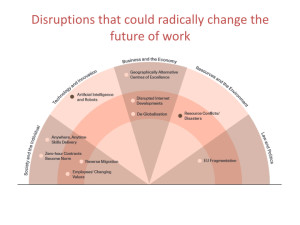 According to the Daily Telegraph, a new UK Government report into the skills crisis in the construction sector has recommended a new levy on house builders in a last ditch attempt to reform the industry.
According to the Daily Telegraph, a new UK Government report into the skills crisis in the construction sector has recommended a new levy on house builders in a last ditch attempt to reform the industry.
The Telegraph reports Mark Farmer, who wrote the review, as warning that “within 10 years the industry would lose 20-25pc of its workforce. He said that Government apprenticeship policies had not done enough, and that it needed to “modernise or die.”
Research undertaken through the EU Learning layers project has identified the challenges to the sector from both the introduction of digital technologies and ecological issues. Digital technology is impacting on the construction industry in different ways. It is enabling the development of new materials, or new ways of producing materials, for instance through 3D printing. Secondly, it is enabling new construction techniques and processes. Building Information Modelling, being phased in as a compulsory requirement for publicly funded project throughout the European Union, represents a major change in the way construction projects are planned and carried out.
The sector also faces pressures with digital technologies from their wider deployment within society and from their potentials to solve or ameliorate societal challenges, for instance climate change.
The European Commission sees the main challenges facing construction as being:
- Stimulating demand: Efficiency improvements in existing buildings and renovations have the highest potential to stimulate demand.
- Training: Improving specialised training and making the sector more attractive, in particular for blue-collar workers, technical colleges and universities.
- Innovation: More active uptake of new technologies.
- Energy efficiency and climate change: Buildings account for the largest share of total EU final energy consumption (40%) and produce about 35% of all greenhouse emissions.
It is interesting that they highlight the need for more active uptake of new technologies. This may be a particular problem given the structure of the industry and the predominance of SMEs with a need for wider access to information and knowledge about new technologies and the skills and competences to use technologies in practice. Discussions with the Bau ABC training centre and construction companies in north west Germany, have raised the issue of training centres playing a more central role in technology innovation, especially with apprentices trained in the centres in using new technologies.
The issue of the attractiveness of the sector to new entrants has also commonly been raised. In Germany it is proving difficult to recruit sufficient apprentices and one project is even running a programme for apprentices from Spain. The use of new mobile technologies for learning is seen as a measure which could promote a more modern image for construction industry.
Technologies are also being deployed to support energy efficiency and ameliorate climate change. These include the installation of digital monitoring and control systems for buildings, geothermal bores as an energy source for new buildings and retrofitting of older buildings for energy efficiency. Although the present ‘hype’ around the Internet of Things (IoT) probably outweighs the reality, it may have a major impact on the construction industry in the near future.
Demands of digital technologies for cabling has led to the introduction of new computer based horizontal boring machines to avoid having to dig up roads to install new cables.
Drones are increasingly being used for surveying and monitoring progress in large construction projects. Although at an early stage in deployment there is widespread interest in the potential of augmented reality applications in construction, for instance to allow the visualisation of hidden infrastructures such as cabling in construction sites.
Building Information Modelling has been the subject of much discussion during the Learning Layers project. European legislation has permitted the adoption of different timetables for implementation in different European Member States. In some countries such as UK and Norway, implementation is at an advanced stage. In others such as Spain and Germany it is less far forward. There is some discussion about what organisations will be responsible for managing and implementing BIM processes as well as the technical approaches to BIM. Will BIM be the responsibility of larger civil engineering enterprises or will employees of small (Craft) companies be required to have a greater or lesser knowledge of BIM? This obviously has major implications for training and skills.
The Daily Telegraph reports that the UK’s commercial sector faces a bill of over £9bn to upgrade properties to meet the minimum energy efficiency standards (MEES), and residential buildings will cost a total of £20bn to meet the necessary level.
Yet with looming skills shortages and the upgrade in skills and knowledge required to cope with new technologies and energy efficient buildings, it seems hard to see how the UK construction industry can adapt to the new demands. Present government proposals are for a short term levy and a reliance on the market system to overcome skills shortages. But as Norman Crowther, national official for post-16 education at the Association of Teachers and Lecturers writing in the Times Educational Supplement (TES), points out a market is not a system per se. “Introducing market mechanisms to get the output you want is not a VET system. All the “market” systems have the same sort of problems around VET (think the US, Australia, New Zealand and Canada). Of course, that’s not a problem as long as you don’t want coherent skill formation and skill utilisation. But in a time of economic uncertainty and poor productivity, a system is exactly what we need.
The German coordinated market economy goes so far as to legislate on vocational education and training, and apprenticeships have labour-market worth. In France, the state coordinates agreement via ministerial committees. The Nordic model has positioned VET as a part of the school curriculum and produced publicly intelligible VET qualifications that resonate with the public.”
The failings of vocational education and training in the UK are hardly new, neither are skills shortages. Yet without developing a proper system based on high quality training both in vocational schools and in the workplace it is only likely these problems will worsen
 Last week I travelled from Derby to Manchester airport by train. It was a typical English Midlands December day – cold, damp and foggy. Waiting at the station was a train driver – I knew this because she had on an orange hi vis jacket with driver printed on the back. At some time a much older male driver came along and they started chatting. The conversation was about the weather – no surprises there. But it seems she had been driving the previous evening when the fog had been very thick and she had never encountered such conditions before. It was fairly obvious that she was new to the job. Her big worry had been not knowing where she was and failing to slow down in time for stations. The more experienced driver sympathized and advised her to slow down to 20 miles an hour. If you go at 20, he said, you will always be able to stop in time. But, he said, don’t worry – as you get more experienced you will get to know where the stations are.
Last week I travelled from Derby to Manchester airport by train. It was a typical English Midlands December day – cold, damp and foggy. Waiting at the station was a train driver – I knew this because she had on an orange hi vis jacket with driver printed on the back. At some time a much older male driver came along and they started chatting. The conversation was about the weather – no surprises there. But it seems she had been driving the previous evening when the fog had been very thick and she had never encountered such conditions before. It was fairly obvious that she was new to the job. Her big worry had been not knowing where she was and failing to slow down in time for stations. The more experienced driver sympathized and advised her to slow down to 20 miles an hour. If you go at 20, he said, you will always be able to stop in time. But, he said, don’t worry – as you get more experienced you will get to know where the stations are. According to the
According to the 


